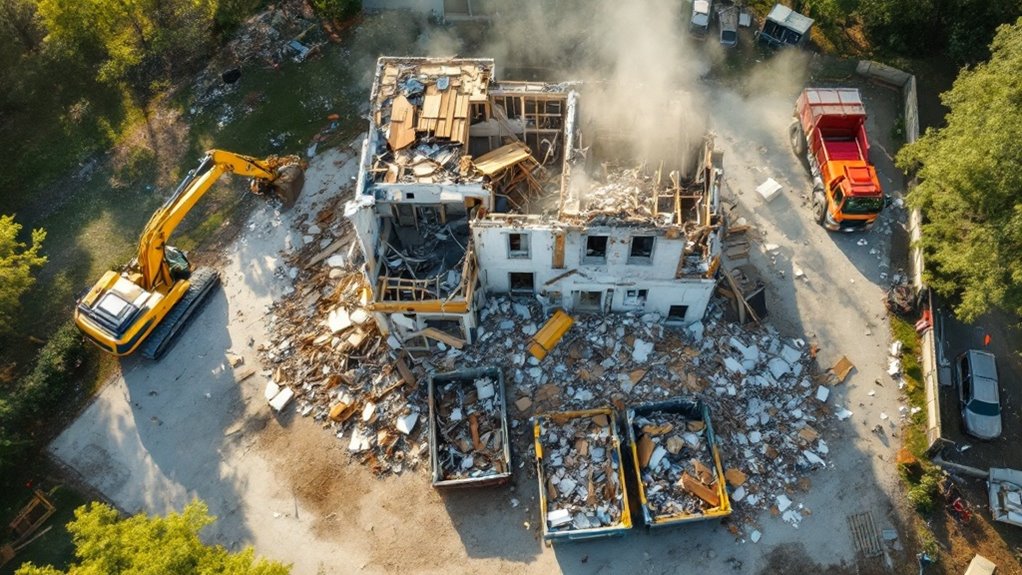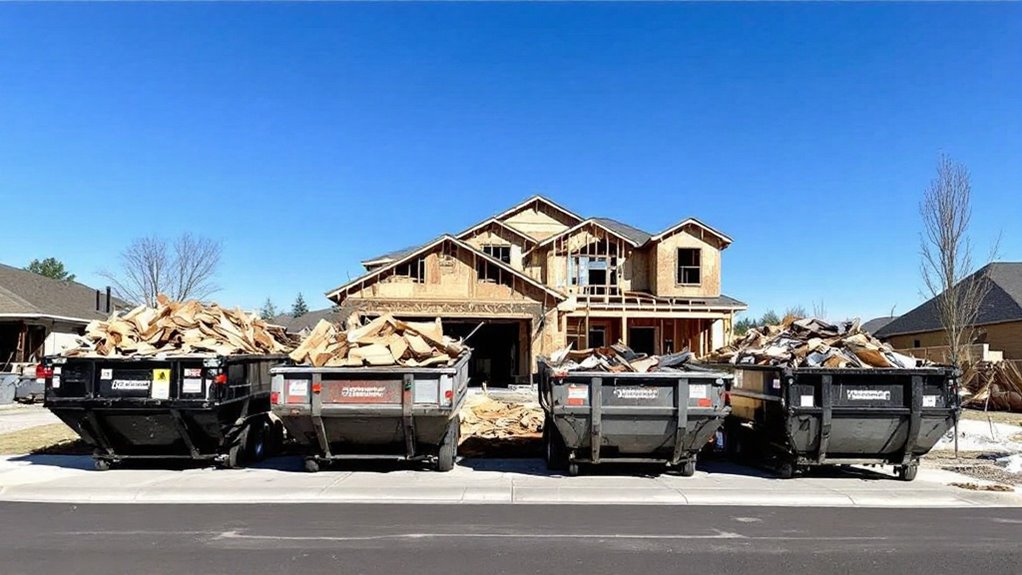You’ll need between 7-14 dumpsters to demolish an average 2,000-square-foot house, which typically generates around 270 cubic yards of debris. The exact number depends on your dumpster sizes, with 20-40 yard containers being most common for home demolitions. You’ll want to separate materials like concrete, wood, and metals into different dumpsters for proper disposal. Understanding key factors like house size and material types will help you plan more accurately.
Key Takeaways
- A 1,000-square-foot house requires approximately 5-7 dumpsters (30-yard size) to handle 135 cubic yards of demolition debris.
- For a 2,000-square-foot house, plan for 9-10 dumpsters (30-yard size) to manage roughly 270 cubic yards of waste.
- Separate heavy materials like concrete into smaller dumpsters to avoid exceeding weight limits and ensure proper disposal.
- Calculate total dumpster needs by dividing total debris volume by dumpster size (Length x Width x Height x 1/3 ÷ 27).
- Plan for different dumpster types to handle various materials, with dedicated containers for metal, wood, concrete, and general debris.
Understanding House Demolition Debris Volume

When planning to demolish a house, you’ll need to estimate the debris volume to organize proper disposal accurately. As a rule of thumb, a 1,000-square-foot house typically generates about 135 cubic yards of debris, while a 2,000-square-foot home produces around 270 cubic yards. Larger homes create proportionally more waste. Since demolition wastes make up 90% of all construction and demolition debris, proper planning is essential.
You’ll want to examine the various materials involved in your demolition project. Different components like wood, concrete, and metal affect the total volume differently. Concrete requires special handling, while wood and combustible materials have their own disposal requirements. Roofing materials can add substantial bulk to your total. For most complete house demolitions, experts recommend using 30 or 40-yard containers to handle the substantial volume of mixed debris. To get the most precise estimate, you can use field measurements, GPS data, or consult historical data from similar demolition projects in your area.
Selecting the Right Dumpster Size for Your Project
Choosing the right dumpster size is pivotal for a successful house demolition project. You’ll want to review both your project scale and the types of materials you’re disposing of. Dumpster sizes range from 10 to 40 cubic yards, and selecting the right one can streamline your demolition process while keeping costs manageable.
For smaller tasks like shed teardowns or yard waste, opt for 10-15 cubic yard dumpsters. When handling heavy materials like concrete, choose smaller containers to avoid exceeding weight limits. Examine 20-40 cubic yard dumpsters for larger demolition phases, which can reduce the total number of containers needed. Remember to separate different materials into designated dumpsters for efficient recycling and disposal.
Keep in mind that a 2,000 square foot house typically generates about 240 cubic yards of debris, so you’ll need to plan accordingly.
Key Factors That Impact Dumpster Requirements
The success of your demolition project hinges on understanding several key factors that determine your dumpster needs. Your house’s size and square footage directly affect debris volume, while the types of materials you’ll remove influence container requirements. For instance, you’ll need specialized heavy-duty dumpsters for concrete and separate ones for lighter materials like wood and drywall.
Your site’s accessibility and available space play essential roles too. Consider overhead obstacles, entrance width, and neighbors when planning dumpster placement. Don’t forget to check local regulations – they’ll dictate disposal methods, permits, and any restrictions on material separation.
Remember that your project timeline matters; efficient debris management keeps your demo on schedule and within budget. Planning around these factors helps you avoid costly delays and guarantees smooth project execution.
Essential Calculations for Debris Estimation
Accurately calculating debris volume stands as the cornerstone of a successful demolition project. You’ll need to measure your house’s length, width, and height, then use the standard formula: Length x Width x Height x 1/3 ÷ 27 to determine cubic yards of debris. This calculation helps you choose the right dumpster size and quantity for your project.
- A 1,000 sq. ft. house typically produces 135 cubic yards of debris
- A 2,000 sq. ft. house generates about 270 cubic yards
- A 3,000 sq. ft. house creates roughly 405 cubic yards
Divide your total debris by your chosen dumpster size (20, 30, or 40 yards)
Remember to round up when calculating the number of dumpsters needed, and consider special requirements for materials like concrete, roofing, or hazardous waste.
Best Practices for Demolition Waste Management

Now that you’ve calculated your debris volume, it’s time to manage that waste effectively. You’ll want to start by implementing source reduction strategies, like preserving any salvageable parts of the structure. This approach not only saves money but also helps our environment.
Set up distinct areas on your site for material sorting – one for metals, another for wood, and separate spaces for concrete and asphalt. You’ll find that proper sorting makes recycling much easier and more profitable.
Work with reliable waste haulers who understand the importance of responsible disposal and recycling. Remember to train your crew on proper waste handling procedures and conduct regular site inspections to verify everyone’s following the plan. This systematic approach will help you maximize recycling opportunities while minimizing disposal costs.
Frequently Asked Questions
Can I Share Dumpsters With Neighbors Doing Similar Demolition Projects?
You can share dumpsters with neighbors, but you’ll need formal agreements, synchronized schedules, and proper permits. Check local regulations first since sharing can save money but requires careful coordination.
How Long in Advance Should I Schedule Dumpster Delivery?
You’ll want to schedule your dumpster delivery 1-2 weeks ahead for small projects, or 2-3 weeks for larger demolitions. During peak seasons, it’s smart to add an extra week.
What Happens if It Rains While My Dumpster Is On-Site?
Rain can increase your debris weight and create handling challenges. You’ll want to monitor the load carefully, guarantee proper drainage, and contact your rental company if weather conditions become problematic.
Are There Special Permits Required for Placing Dumpsters on Public Streets?
You’ll need permits for placing dumpsters on public streets, obtained from your city’s public works department. Don’t worry about permits if you’re using private property like your driveway.
Can Hazardous Materials Like Asbestos Go in Regular Demolition Dumpsters?
You can’t put asbestos in regular demolition dumpsters. It’s illegal and dangerous. You’ll need to hire a licensed asbestos removal specialist who’ll properly dispose of it at authorized facilities.
Conclusion
You’ll need to carefully plan your dumpster requirements based on your house’s size and construction type. For an average 1,500-square-foot home, expect to use 3-4 40-yard dumpsters. Remember to factor in material types, local disposal regulations, and staging area space. Consider renting dumpsters in phases to manage costs and guarantee efficient waste removal throughout your demolition project. If you’re only disposing of a section of the house like a Hardwood flooring, drywall or a fireplace, consider reading our other articles.